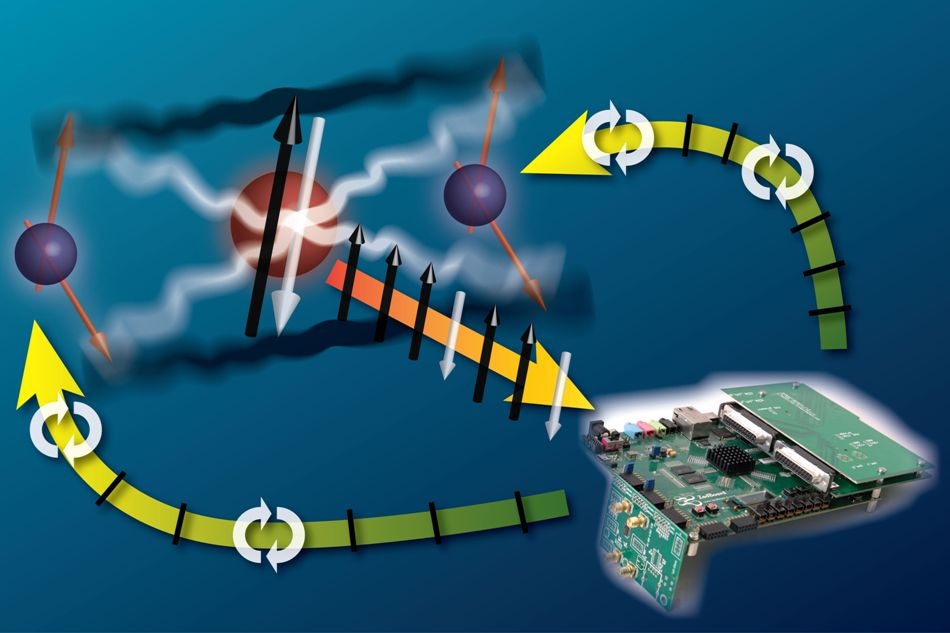Nov 7 2018
It is possible to manipulate the existing quantum systems with extremely high, but not flawless precision. At present, physicists from ETH have shown the way to monitor and correct errors that occur at the time of such operations.
 The quantum correlations between two beryllium ions (represented as blue spheres) are sequentially measured using an ancillary calcium ion (red sphere) and stabilized by feedback control through a powerful classical control system (bottom right) that features flexible in-sequence processing. (Image credit: ETH Zurich/Home group)
The quantum correlations between two beryllium ions (represented as blue spheres) are sequentially measured using an ancillary calcium ion (red sphere) and stabilized by feedback control through a powerful classical control system (bottom right) that features flexible in-sequence processing. (Image credit: ETH Zurich/Home group)
In the last few years, the field of quantum computation has undergone enormous advancement. Gradually, quantum devices have started to challenge traditional computers, at least in a few chosen tasks. Despite the progress, existing quantum information processors have been struggling to cope with errors, which inevitably occur as part of any calculation. This lack of ability to effectively rectify errors, in turn, hampers the efforts toward sustained large-scale quantum information processing. This is the reason for the excitement behind a set of experiments in which the team of Jonathan Home from the Institute for Quantum Electronics integrated for the first time various elements required for carrying out quantum error correction in a single experiment. These outcomes have been reported in the Nature journal on November 5th, 2018.
Making imperfection tolerable
Quite similar to their classical equivalents, quantum computers are developed from imperfect components and are far more sensitive to disturbances from the outside. This unavoidably results in errors when calculations are performed. In the case of traditional computers, there is a well-established toolkit for the detection and correction of such errors. Quantum computers are more dependent on locating and fixing errors. This leads to a need for conceptually distinct strategies that consider the fact that information is encoded in quantum states. Specifically, it is highly difficult to repeatedly read out quantum information without disturbing it, which is required for detecting errors, and to react in real time to fix these errors.
Repeat performance
The quantum information in the quantum states of single ions strung together in a trap are encoded by the Home group. It is normal for these strings to contain ions of only one species. However, PhD students Vlad Negnevitsky and Matteo Marinelli, collaborated with postdoc Karan Mehta and other colleagues and have currently developed strings in which they trapped two distinctive species, one calcium ion (40Ca+) and two beryllium ions (9Be+). Although mixed-species strings such as these have been produced even earlier, the researchers have now used them in innovative ways.
They exploited uniquely different properties of the two species. Specifically, beryllium and calcium ions are manipulated and measured in the experiments using highly distinct colors of light. This opens the path for working on one species without perturbing the other. Simultaneously, the ETH team discovered techniques to enable the dissimilar ions to interact with one another in ways that measurements on the calcium ion provide information related to the quantum states of the beryllium ions, without affecting those fragile states. Of importance is the fact that the beryllium ions were repeatedly monitored by the physicists as they were subjected to imperfections and errors. They carried out 50 measurements on the same system, in contrast to earlier experiments where only calcium ions were used and such repeated readout was limited to just a few rounds.
Corrective action
Spotting errors and taking steps to fix them are two completely different tasks. In order to fix the errors, the team created a robust control system for repeatedly nudging the beryllium ions based on the extent to which they strayed away from the target state. Complex information processing at microsecond timescales was needed for bringing the ions back on track. Since classical control electronics is used by the system, the strategy demonstrated currently should hold good for quantum-computation platforms based on information carriers other than trapped ions.
Of significance is that Negnevitsky, Marinelli, Mehta, and their colleagues showed that these techniques could also be used for stabilizing states where the two beryllium ions shared entangled quantum states, that is, states with no direct equivalent in classical physics. Entanglement is one element that proffers quantum computers with distinctive capabilities. Furthermore, it is possible to also use these states to improve the accuracy of precision measurements. Elements for error correction such as those shown currently have the ability to make these states last longer—offering interesting prospects not just for quantum computation but even for metrology.